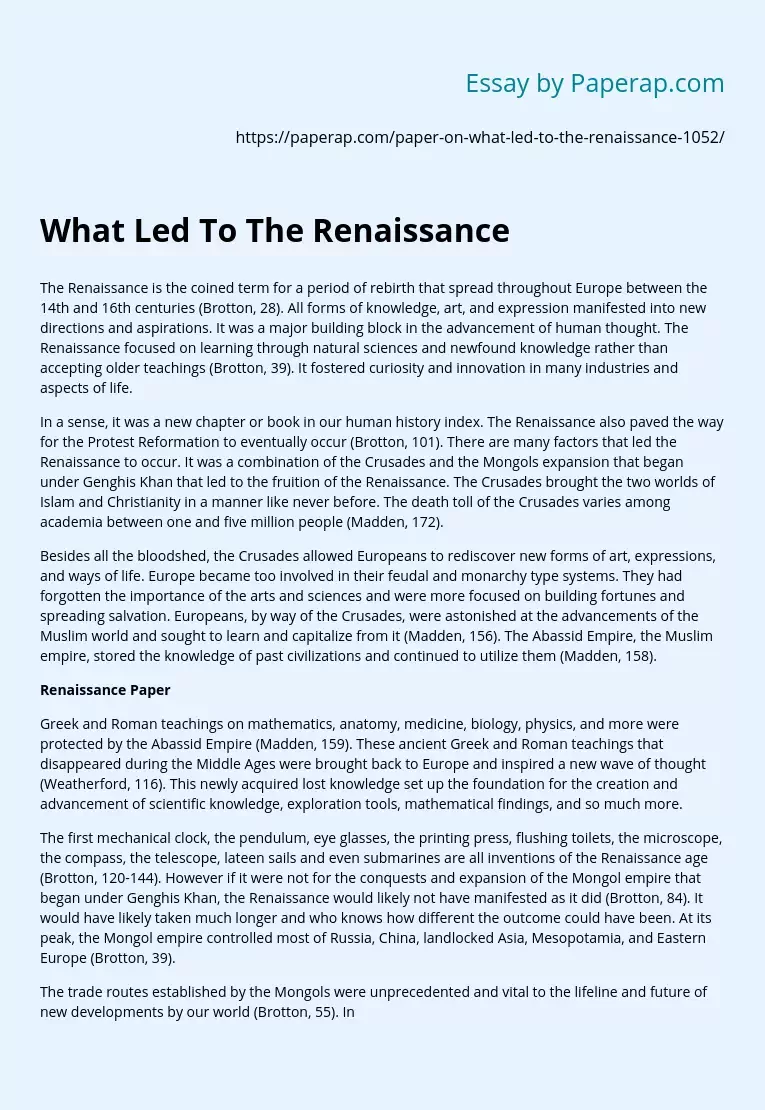What Led To The Renaissance
The Renaissance is the coined term for a period of rebirth that spread throughout Europe between the 14th and 16th centuries (Brotton, 28). All forms of knowledge, art, and expression manifested into new directions and aspirations. It was a major building block in the advancement of human thought. The Renaissance focused on learning through natural sciences and newfound knowledge rather than accepting older teachings (Brotton, 39). It fostered curiosity and innovation in many industries and aspects of life.
In a sense, it was a new chapter or book in our human history index.
The Renaissance also paved the way for the Protest Reformation to eventually occur (Brotton, 101). There are many factors that led the Renaissance to occur. It was a combination of the Crusades and the Mongols expansion that began under Genghis Khan that led to the fruition of the Renaissance. The Crusades brought the two worlds of Islam and Christianity in a manner like never before. The death toll of the Crusades varies among academia between one and five million people (Madden, 172).
Besides all the bloodshed, the Crusades allowed Europeans to rediscover new forms of art, expressions, and ways of life. Europe became too involved in their feudal and monarchy type systems. They had forgotten the importance of the arts and sciences and were more focused on building fortunes and spreading salvation. Europeans, by way of the Crusades, were astonished at the advancements of the Muslim world and sought to learn and capitalize from it (Madden, 156). The Abassid Empire, the Muslim empire, stored the knowledge of past civilizations and continued to utilize them (Madden, 158).
Renaissance Paper
Greek and Roman teachings on mathematics, anatomy, medicine, biology, physics, and more were protected by the Abassid Empire (Madden, 159). These ancient Greek and Roman teachings that disappeared during the Middle Ages were brought back to Europe and inspired a new wave of thought (Weatherford, 116). This newly acquired lost knowledge set up the foundation for the creation and advancement of scientific knowledge, exploration tools, mathematical findings, and so much more.
The first mechanical clock, the pendulum, eye glasses, the printing press, flushing toilets, the microscope, the compass, the telescope, lateen sails and even submarines are all inventions of the Renaissance age (Brotton, 120-144). However if it were not for the conquests and expansion of the Mongol empire that began under Genghis Khan, the Renaissance would likely not have manifested as it did (Brotton, 84). It would have likely taken much longer and who knows how different the outcome could have been. At its peak, the Mongol empire controlled most of Russia, China, landlocked Asia, Mesopotamia, and Eastern Europe (Brotton, 39).
The trade routes established by the Mongols were unprecedented and vital to the lifeline and future of new developments by our world (Brotton, 55). In short, it picked up where the Crusades left off and brought these ideas and items into motion. Major cities like Baghdad, Hangzhou, and Istanbul, were pillars of advancement and cultural strength. These cities and many more were conquered by the Mongols (Brotton, 39). With their empire eventually extending to as far as Venice, all types of intercultural communication and trade occurred (Brotton, 41).
This mixing of cultures led to newfound ideas in many facets of life. All this setting the stage for the Renaissance. The Crusades, the Mongol’s empire and trade routes, and the Renaissance, were a natural progression of events that each led to major societal changes. It’s most appropriate to credit the Crusades for inspiring the initial interests and desires that sparked the Renaissance. However, it was the Mongols that brought the Renaissance to actuality by connecting countries and cultures through conquests like never before.
It’s difficult to say which is more responsible, one is ideologically responsible and another is infra-structurally responsible. Both played vital, but different, roles that set the stage for what eventually became the Renaissance. WORKS CITED Brotton, Jerry. The Renaissance: A Very Short Introduction. New York: Oxford University Press, 2006. Print. 160 Madden, Thomas. The Crusades: The Essential Readings. New Jersey: Wiley-Blackwell, 2002. Print. 288 Weatherford, Jack. Genghis Khan and the Making of the Modern World. New York: Crown Publishers, 2004. Print. 317
What Led To The Renaissance. (2019, Dec 05). Retrieved from https://paperap.com/paper-on-what-led-to-the-renaissance-1052/

